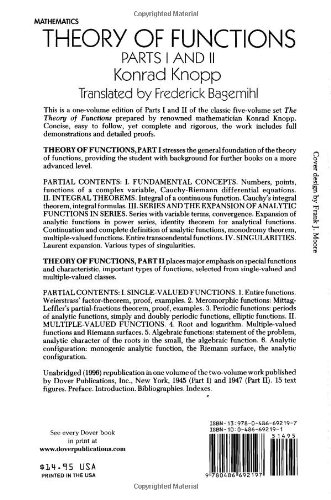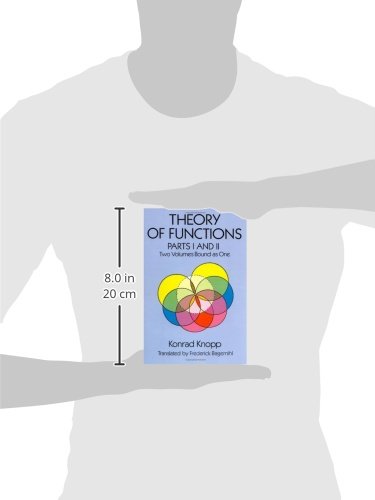



Theory of Functions, Parts I and II (Dover Books on Mathematics)
A**R
a bibliographic note
I have yet to work through the book, but its place in Knopp's original five-volume sequence was not apparent from Amazon's or Dover's product descriptions, so I list the entire sequence here (Dover English editions, translated from the German originals), followed by the tables of contents, which I had difficulty finding in one place:Volume 1: Elements of the Theory of Functions , ISBN-10: 0486601544, ISBN-13: 978-0486601540; this volume is cited as a prerequisite on page 1 the next volume. Unfortunately it is out of print but used copies (or substitutes) can be found.Volumes 2 and 3 (the current book): Theory of Functions, Parts I and II (Dover Books on Mathematics) (Pts. 1 & 2) . ISBN-10: 0486692191, ISBN-13: 978-0486692197Volumes 4 and 5: Problem Book in the Theory of Functions (Dover Books on Mathematics) . ISBN-10: 0486414515, ISBN-13: 978-0486414515.Volume 1 (Elements of the Theory of Functions) Table of Contents:------------------------------------------------------------Section I. Complex Numbers and their Geometric RepresentationChapter I. Foundations1. Introduction2. The system of real numbers3. Pointgs and vectors of the planeChapter II. The System of Complex Numbers and the Gaussian Plane of Numbers4. Historical remarks5. Introduction of complex numbers. Notation6. Equality and inequality7. Addition and subtraction8. Multiplication and division9. Derived rules. Powers10. The system of complex numbers as an extension of the system of real numbers11. Trigonometric representation of complex numbers12. Geometric representation of multiplication and division13. Inequalities and absolute values. ExamplesChapter III. The Riemann Sphere of Numbers14. The stereographic projection15. The Riemann sphere of numbers. The point infinity. ExamplesSection II. Linear Functions and Circular TransformationsChapter IV. Mapping by Means of Linear Functions16. Mapping by means of entire linear functions17. Mapping by means of the function w = 1/z18. Mapping by means of arbitrary linear functionsChapter V. Normal Forms and Particular Linear Mappings19. The group-property of linear transformations20. Fixed points and normal forms21. Particular linear mappings. Cross ratios22. Further examplesSection III. Sets and Sequences. Power SeriesChapter VI. Point Sets and Sets of Numbers23. Point sets24. Sets of real numbers25. The Bolzano-Weierstrass theoremChapter VII. Sequences of Numbers. Infinite Series26. Sequences of complex numbers27. Sequences of real numbers28. Infinite seriesChapter VIII. Power Series29. The circle of convergence30. Operations on power seriesSection IV. Analytic Functions and Conformal MappingChapter IX. Functions of a Complex Variable31. The concept of a function of a complex variable32. Limits of functions33. Continuity34. Differentiability35. Properties of functions represented by power seriesChapter X. Analytic Functions and Conformal Mapping36. Analytic functions37. Conformal mappingSection V. The Elementary FunctionsChapter XI. Power and Root. The Rational Functions38. Power and root39. The entire rational functions40. The fractional rational functionsChapter XII. The Exponential, Trigonometric, and Hyperbolic Functions41. The exponential function42. The functions cos z and sin z43. The functions tan z and cot z44. The hyperbolic functionsChapter XIII. The Logarithm, the Cyclometric Functions, and the Binomial Series45. The logarithm46. The cyclometric functions47. The binomial series and the general powerBibliography; IndexVolume 2 and 3 (Theory of Functions, Parts I and II) Table of Contents:------------------------------------------------------------PART I: ELEMENTS OF THE GENERAL THEORY OF ANALYTIC FUNCTIONSSection I. Fundamental ConceptsChapter 1. Numbers and Points1. Prerequisites2. The Plane and Sphere of Complex Numbers3. Point Sets and Sets of Numbers4. Paths, Regions, ContinuaChapter 2. Functions of a Complex Variable5. The Concept of a Most General (Single-valued) Function of a Complex Variable6. Continuity and Differentiability7. The Cauchy-Riemann Differential EquationsSection II. Integral TheoremsChapter 3. The Integral of a Continuous Function8. Definition of the Definite Integral9. Existence Theorem for the Definite Integral10. Evaluation of Definite Integrals11. Elementary Integral TheoremsChapter 4. Cauchy's Integral Theorem12. Formulation of the Theorem13. Proof of the Fundamental Theorem14. Simple Consequences and ExtensionsChapter 5. Cauchy's Integral Formulas15. The Fundamental Formula16. Integral Formulas for the DerivativesSection III. Series and the Expansion of Analytic Functions in SeriesChapter 6. Series with Variable Terms17. Domain of Convergence18. Uniform Convergence19. Uniformly Convergent Series of Analytic FunctionsChapter 7. The Expansion of Analytic Functions in Power Series20. Expansion and Identity Theorems for Power Series21. The Identity Theorem for Analytic FunctionsChapter 8. Analytic Continuation and Complete Definition of Analytic Functions22. The Principle of Analytic Continuation23. The Elementary Functions24. Continuation by Means of Power Series and Complete Definition of Analytic Functions25. The Monodromy Theorem26. Examples of Multiple-valued FunctionsChapter 9. Entire Transcendental Functions27. Definitions28. Behavior for Large zSection IV. SingularitiesChapter 10. The Laurent Expansion29. The Expansion30. Remarks and ExamplesChapter 11. The Various types of Singularities31. Essential and Non-essential Singularities or Poles32. Behavior of Analytic Functions at Infinity33. The Residue Theorem34. Inverses of Analytic Functions35. Rational FunctionsBibliography; IndexPART II: APPLICATIONS AND CONTINUATION OF THE GENERAL THEORYIntroductionSection I. Single-valued FunctionsChapter 1. Entire Functions1. Weierstrass's Factor-theorem2. Proof of Weierstrass's Factor-theorem3. Examples of Weierstrass's Factor-theoremChapter 2. Meromorphic Func4. Mittag-Leffler's Theorem5. Proof of Mittag-Leffler's Theorem6. Examples of Mittag-Leffler's TheoremChapter 3. Periodic Functions7. The Periods of Analytic Functions8. Simply Periodic Functions9. Doubly Periodic Functions; in Particular, Elliptic FunctionsSection II. Multiple-valued FunctionsChapter 4. Root and Logarithm10. Prefatory Remarks Concerning Multiple-valued Functions and Riemann Surfaces11. The Riemann Surfaces for p(root)z and log z12. The Riemann Surfaces for the Functions w = root(z - a1)(z - a2) . . . (z - ak)Chapter 5. Algebraic Functions13. Statement of the Problem14. The Analytic Character of the Roots in the Small15. The Algebraic FunctionChapter 6. The Analytic Configuration16. The Monogenic Analytic Function17. The Riemann Surface18. The Analytic ConfigurationBibliography, IndexVolume 4 and 5 (Problem Book in the Theory of Functions, Two Volumes Bound As One) Table of Contents:------------------------------------------------------------Volume I: Problems in the Elementary Theory of FunctionsChapter I. Fundamental Concepts1. Numbers and Points. Problems; Answers2. Point Sets. Paths. RegionsChapter II. Infinite Sequences and Series3. Limits of Sequences. Infinite Series with Constant Terms. Problems; Answers4. Convergence Properties of Power Series. Problems; AnswersChapter III. Functions of a Complex Variable5. Limits of Functions. Continuity and Differentiability. Problems; Answers6. Simple Properties of the Elementary Functions. Problems; AnswersChapter IV. Integral Theorems7. Integration in the Complex Domain. Problems; Answers8. Cauchy's Integral Theorems and Integral Formulas. Problems; AnswersChapter V. Expansion in Series9. Series with Variable Terms. Uniform Convergence. Problems; Answers10. Expansion in Power Series. Problems; Answers11. Behaviour of Power Series on the Circle of Convergence. Problems; AnswersChapter V. Conformal Mapping12. Linear Functions. Stereographic Projection. Problems; Answers13. Simple Non-Linear Mapping Problems. Problems; AnswersVolume II: Problems in the Advanced Theory of FunctionsForewordChapter I. Additional Problems for I, Chs. 1-51. Fundamental Concepts2. Infinite Sequences and Series3. Functions of a Complex Variable4. Integral Theorems5. Expansions in SeriesChapter II. Singularities6. The Laurent Expansion7. The Various Types of Singularities8. The Residue Theorem, Zeros, and PolesChapter III. Entire and Meromorphic Functions9. Infinite Products. Weierstrass's Factor-theorem10. Entire Functions11. Partial-fractions Series. Mittag-Leffler's Theorem12. Meromorphic FunctionsChapter IV. Periodic Function13. Simply Periodic Functions14. Doubly Periodic FunctionsChapter V. Analytic Continuation15. Behavior of Power Series on the Boundary of the Circle of Convergence16. Analytic Combination of Power Series17. Analytic Continuation of Arbitrarily Given FunctionsChapter VI. Multiple-valued Functions and Riemann Surfaces18. Multiple-valued Functions in General19. Multiple-valued Functions; in Particular, Algebraic FunctionsChapter VII. Conformal Mapping20. Concept and General Theory21. Specific Mapping Problems
J**N
a compact introduction to the central theories of modern analysis
The book is remarkably concise in covering a wide range of subject matter in a clear and coherent manner. There are four sections: I. "Fundamental concepts", II. "Integral Theorems", III. "Series and the Expansion of Analytic Functions in Series", and IV. "Singularities". While the third section is the longest, the emphasis throughout is on analytic functions, especially in regard to functions of a complex variable. Cauchy's contributions to the conditions met by analytic functions, and the evaluation of their singularities, are emphasized, as they should be.The translation, by Frederick Bagemihi, is remarkably clear, and the reprint(s), by Dover, are quite inexpensive and available in a choice of formats (one or two volumes). There is also a preliminary small volume, "Elements...", as well asproblem books, available as one or two small volumes.
W**T
It is not as theoretically detailed as Walter Rudin's "Real and Complex Analysis" but it is an excellent treatment of the subjec
This is one of the classics of complex analysis. It is not as theoretically detailed as Walter Rudin's "Real and Complex Analysis" but it is an excellent treatment of the subject. It is best used in conjunction with the "Problem Book" by the same author.
D**P
Excellent Introduction to Subject
This book is an inexpensive but great introduction to the Theory of Functions. Combining 2 volumes into 1 is an excellent idea. I highly recommend this Dover reprint.
A**E
Outdated and too many inaccurate logical steps.
Purchase of this Dover book was a mistake. It was meant for replacement for Ahlfors's complex analysis.Hope Dover give us ahlfors' .
T**.
Not for me
Good for math purists but a little too detailed for me.
V**N
Three Stars
good
E**E
Five Stars
Excellent
T**O
A book of the good old days
For the present I should like to recommend this book to the uninitiated concerning complex analysis inasmuch as Ahlfors's book is priced too high to get a copy easily. Why the heck is that book that expensive? I couldn't believe my eyes. Did a popular edition go out of print? To tell the truth, I hesitated to write my review concerning that book, but summoned up my courage to write that review in the sense that the worth of that book is one thing, and its price another. Be that as it may, it's desirable that a popular edition should be reissued.To cut this digression short, I must return to this book. Needless to say, the book is classic, and so passes down German mathematics of the good old days, especially the prewar days; consequently neither homology nor homotopy appears in the book. Even so, it must be sufficient for the uninitiated to learn the subject. Ahlfors's book
Trustpilot
2 weeks ago
1 day ago